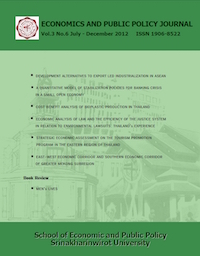A QUANTITATIVE MODEL OF STABILIZATION POLICIES FOR BANKING CRISIS IN A SMALL OPEN ECONOMY
Main Article Content
บทคัดย่อ
This study constructs a framework that can account for banking crisis for a small open economy. It then explores how the stabilization policies consisting of 1) tight monetary policy, which was guided by the International Monetary Fund during the Asian Financial Crisis and 2) unconventional monetary policy, which was implemented by the Federal Reserve, find the way out of this unfavorable financial turmoil. This observation also applies to Thailand’s economic conditions during 1997-1998 as an example of banking crisis characteristics. The result of this study is consistent to Stigliz (2002) that the tight monetary policy increases borrowing cost and even deteriorates the economy. It also points out that the policymaker is supposed to pacify the banking distress through the unconventional monetary policy rather than the tight monetary policy because it can pacify the severity of the financial crisis.
Article Details
ประเภทบทความ
บทความวิจัย
สงวนลิขสิทธิ์ © 2553 คณะเศรษฐศาสตร์ มหาวิทยาลัยศรีนครินทรวิโรฒ
คณะเศรษฐศาสตร์ มหาวิทยาลัยศรีนครินทรวิโรฒ จัดพิมพ์วารสารเศรษฐศาสตร์และนโยบายสาธารณะ เพื่อเผยแพร่บทความวิชาการทางเศรษฐศาสตร์ นโยบายสารธารณะ และสาขาอื่นๆที่เกี่ยวข้อง ทัศนะและข้อคิดเห็นใดๆ ที่ปรากฏในวารสารเป็นความคิดเห็นส่วนตัวของผู้เขียน โดยบทความที่ได้รับการตอบรับจะถือเป็นลิขสิทธิ์ของคณะเศรษฐศาสตร์ มหาวิทยาลัยศรีนครินทรวิโรฒ
บรรณาธิการ อาจารย์ ดร.พลพัธน์ โคตรจรัส


